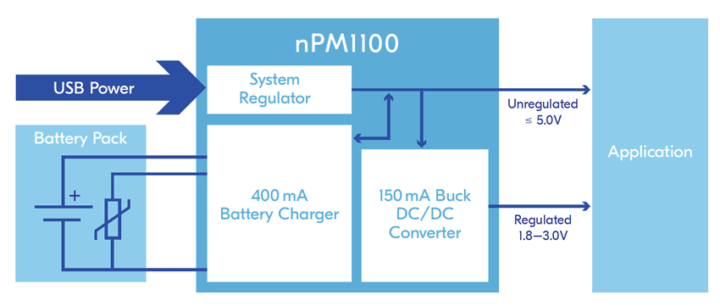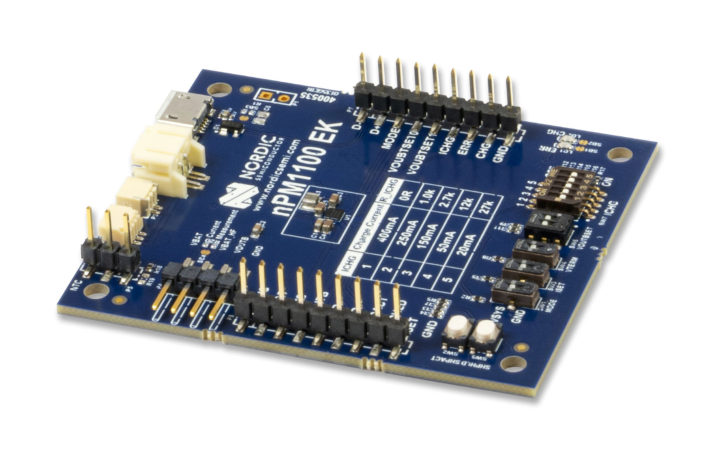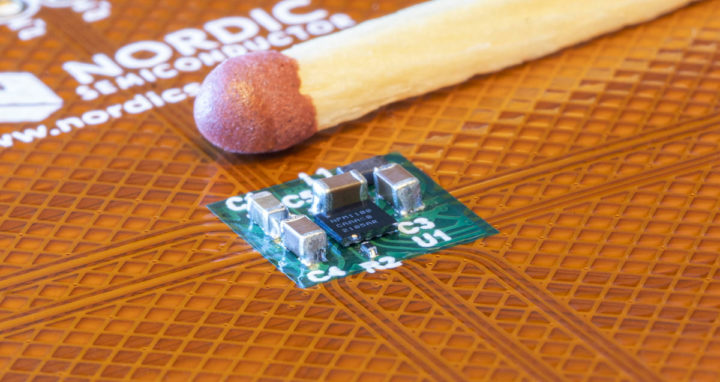Nordic Semi is well-known for its 2.4GHz multi-protocol chips such as nRF52840 or nRF52832 that are typically found in battery-powered devices such as smartwatches with Bluetooth connectivity.
But once rechargeable batteries are involved that means a charging circuit is needed, and for instance, PineTime nRF52832 based watch relies on SGMicro SGM40561 Li-Ion battery charger and SGM2036 low-power regulator. So Nordic Semi has decided to get involved in the power management business and launched its first PMIC with nPM1100 combining a USB-compatible Li-ion/Li-Po battery charger and an efficient DC/DC buck regulator in a single, compact WLCSP package.
Nordic Semi nPM1100 PMIC key features and specifications:
- 400 mA battery charger
- USB compatible input regulator
- Up to 150 mA of regulated voltage output at 1.8, 2.1, 2.7, or 3.0 V
- Overvoltage protection
- Ship mode disables power output
- Low quiescent currents
- Drivers for charge and error LEDs
- Supports Lithium-Ion and LiPo batteries with a nominal voltage of 3.6 to 3.7 V
- Power conversion efficiency up to 92%
- Dimensions – 2.075 x 2.075 mm (WLCSP package )
- Temperature Range – -40°C to 85°C

The PMIC is designed for work with the company’s nRF52 and nRF53 Series wireless SoCs, but can also be integrated with other IC as a generic PMIC. Since it is highly integrated with the PCB usage area as low as 23 mm2, it’s best suited for wearables, connected medical devices, and other space-constrained applications.
Nordic further explains the power management IC embeds battery thermal protection and automatic selection of three charging modes, namely automatic trickle, constant current, and constant voltage., as well as discharge current limitation and JEITA compliance. nPM1100 can also be configured for soft startup and automatic transition between hysteretic and pulse width modulation (PWM) modes, or a forced PWM mode, without configuration software, as all settings are pin configurable.
 The company will also offer an evaluation platform – nPM1100 EK – with switches for all selectable settings, buttons to enter and exit ship mode, as well as connectors for batteries, USB, and headers for all pins on the PMIC. The evaluation kit can be used with other Nordic Development Kits (DKs) or to test out the PMIC’s functionality with non-Nordic products.
The company will also offer an evaluation platform – nPM1100 EK – with switches for all selectable settings, buttons to enter and exit ship mode, as well as connectors for batteries, USB, and headers for all pins on the PMIC. The evaluation kit can be used with other Nordic Development Kits (DKs) or to test out the PMIC’s functionality with non-Nordic products.
If we take our PineTime watch as an example, the SGM40561 charger measures 2x2mm while the SGM2036 regulator takes 1×1 mm on the PCB, plus external components, while nPM1100 measures just 2x2mm, with the complete circuit taking 23 mm2 and up. So If Pine64 were to switch to nPM1100 PMIC on a future PineTime 2 watch they may be able to keep the same form factor, add an extra sensor, and potentially improve battery life.
More details can be found on the product page and press release, and if you’d like to really find out more Nordic is organizing a webinar on June 9 where you can get your questions answered and learn:
- Why Nordic Semiconductor is launching a PMIC
- Technical details of the nPM1100
- What this product can do for your application

Jean-Luc started CNX Software in 2010 as a part-time endeavor, before quitting his job as a software engineering manager, and starting to write daily news, and reviews full time later in 2011.
Support CNX Software! Donate via cryptocurrencies, become a Patron on Patreon, or purchase goods on Amazon or Aliexpress






I haven’t gone into the details yet, but one interesting thing here is an apparently extremely low quiescent current (under 1 µA). Many many boards suffer the issue that even with the processor in some form of deep sleep and down to micro-amps, the LDO or other power regulator is drawing a lot more current (tens of µA, sometimes a LOT more) than the processor, which kills battery life. It remains to be seen if that very low current is achievable even when providing a little bit of regulated power to the processor, but if that’s the case it could be an extremely interesting chip. The max regulated current is a bit low for some applications (e.g. an ESP32) but it’s more than appropriate for the nRF52 range.